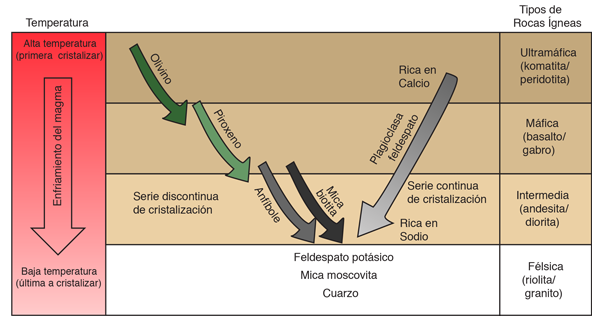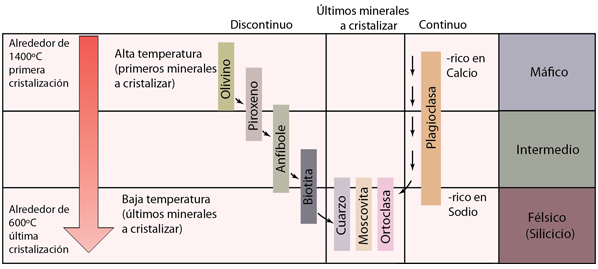Serie de Reacciones de Bowen
En la primera parte del siglo 20, N. L. Bowen realizó experimentos para caracterizar el proceso de cristalización de las rocas ígneas del magma. La ilustración de abajo sigue el modelo de la perspectiva de Lutgens y Tarbuck sobre esa serie de reacciones.

La diferencia en la temperatura de cristalización para los diferentes tipos de minerales producidos cuando se enfria el magma, juega un papel importante en la diferenciación de la composición de la roca.
Another instructive illustration of the Bowen Reaction Series can be found in Chapter 4 of Marshak's Essentials of Geology. The illustration below is patterned after his version. Marshak describes the original experiments of Norman L. Bowen in the 1920s when he heated powdered mafic igneous rock to 1,280°C to melt it. By sequential quenching by sudden cooling, he could identify the temperatures at which different types of minerals would crystalize from the melt. In the temperature range 650°C to 850°C only about 10% of the sample remained melted, and it had a high silica content. At the final stage of crystallization, the felsic materials quartz, K-feldspar and muscovite were formed.

Note that the range of crystallization temperatures in these illustrations is characteristic of the environment of rock that contains these minerals, as in magma beneath the Earth's surface. The melting temperatures of pure minerals may be quite different. For example, in the Bowen reaction series, quartz is crystallizing around 650°C, but pure quartz at one atmosphere pressure does not melt until about 1700°C. (See Quartz Wiki, 1670°C for β-tridymite and 1713°C for β-cristobalite)
Conceptos de Roca Ígnea
Referencia
Lutgens & Tarbuck
Cap. 3
| HyperPhysics*****Geofísica | M Olmo R Nave |